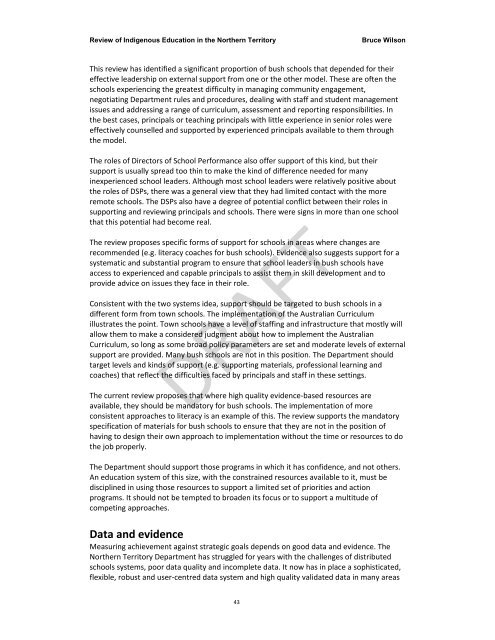Indigenous-Education-Review_DRAFT
Indigenous-Education-Review_DRAFT
Indigenous-Education-Review_DRAFT
Create successful ePaper yourself
Turn your PDF publications into a flip-book with our unique Google optimized e-Paper software.
<strong>Review</strong> of <strong>Indigenous</strong> <strong>Education</strong> in the Northern Territory<br />
Bruce Wilson<br />
This review has identified a significant proportion of bush schools that depended for their<br />
effective leadership on external support from one or the other model. These are often the<br />
schools experiencing the greatest difficulty in managing community engagement,<br />
negotiating Department rules and procedures, dealing with staff and student management<br />
issues and addressing a range of curriculum, assessment and reporting responsibilities. In<br />
the best cases, principals or teaching principals with little experience in senior roles were<br />
effectively counselled and supported by experienced principals available to them through<br />
the model.<br />
The roles of Directors of School Performance also offer support of this kind, but their<br />
support is usually spread too thin to make the kind of difference needed for many<br />
inexperienced school leaders. Although most school leaders were relatively positive about<br />
the roles of DSPs, there was a general view that they had limited contact with the more<br />
remote schools. The DSPs also have a degree of potential conflict between their roles in<br />
supporting and reviewing principals and schools. There were signs in more than one school<br />
that this potential had become real.<br />
The review proposes specific forms of support for schools in areas where changes are<br />
recommended (e.g. literacy coaches for bush schools). Evidence also suggests support for a<br />
systematic and substantial program to ensure that school leaders in bush schools have<br />
access to experienced and capable principals to assist them in skill development and to<br />
provide advice on issues they face in their role.<br />
Consistent with the two systems idea, support should be targeted to bush schools in a<br />
different form from town schools. The implementation of the Australian Curriculum<br />
illustrates the point. Town schools have a level of staffing and infrastructure that mostly will<br />
allow them to make a considered judgment about how to implement the Australian<br />
Curriculum, so long as some broad policy parameters are set and moderate levels of external<br />
support are provided. Many bush schools are not in this position. The Department should<br />
target levels and kinds of support (e.g. supporting materials, professional learning and<br />
coaches) that reflect the difficulties faced by principals and staff in these settings.<br />
<strong>DRAFT</strong><br />
The current review proposes that where high quality evidence‐based resources are<br />
available, they should be mandatory for bush schools. The implementation of more<br />
consistent approaches to literacy is an example of this. The review supports the mandatory<br />
specification of materials for bush schools to ensure that they are not in the position of<br />
having to design their own approach to implementation without the time or resources to do<br />
the job properly.<br />
The Department should support those programs in which it has confidence, and not others.<br />
An education system of this size, with the constrained resources available to it, must be<br />
disciplined in using those resources to support a limited set of priorities and action<br />
programs. It should not be tempted to broaden its focus or to support a multitude of<br />
competing approaches.<br />
Data and evidence<br />
Measuring achievement against strategic goals depends on good data and evidence. The<br />
Northern Territory Department has struggled for years with the challenges of distributed<br />
schools systems, poor data quality and incomplete data. It now has in place a sophisticated,<br />
flexible, robust and user‐centred data system and high quality validated data in many areas<br />
43


